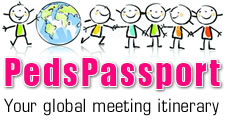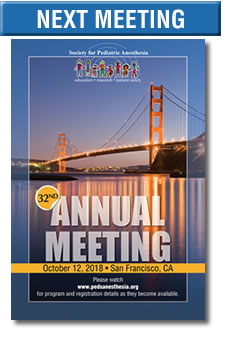Pediatric Anesthesiology 2018 Reviews
Friday Session IV
Global Pediatric Anesthesia and Surgery: Landscape, Pearls and Pitfalls
Reviewed by Andrea Gomez Morad, MD
Assistant in Perioperative Anesthesia and Pain Medicine
Department of Anesthesiology
Critical Care and Pain Medicine
Boston Children’s Hospital
Responsible participation on International Volunteer Surgical Teams
For the first time at a SPA meeting, we had the opportunity to attend a session dedicated to Global Pediatric Anesthesia. As part of this session Mark A. Singleton, MD (UCSF and Stanford, California) talked about the work of volunteers in surgical missions, the ethics and safety dilemmas encountered during these trips and added some recommendations of how to overcome those challenges.
The word “mission” originates back in 1598; it was first used to describe the process of sending priests or members of the Jesuit community abroad to establish schools and churches. The word derives from the Latin “missionem” that means “act of sending”. Nowadays, mission trips are mainly voluntary and although many of them are still related to religious groups, the main drive of the volunteers doing these trips remains the desire to improve the lives of people who live in difficult circumstances.
Dr. Singleton mentioned that International volunteer surgical trips (widely know as surgical mission trips) have been performed for many years. Surgeons, anesthesia providers (anesthesiologists and certified registered nurse anesthetists), nurses, pediatricians, and other health care related workers are increasingly interested in helping resource-limited areas. Currently, there are hundreds of surgical mission trips happening every year. As expected, this increase in interest has caused an increase in regulations, laws and requirements in many countries making the process more difficult and requiring the creation of foundations with administrative staff to support those efforts.
Those of us who have participated in these mission trips understand that these trips are full of both rewarding experiences as well as occasional difficult moments. Despite a trip full of well-trained clinicians with good intentions, problems and complications arise. In order to improve the quality of the care provided on those trips, multiple guidelines have been developed to help guide these efforts. In addition, there are also global quality initiatives developed to look at outcomes from these types of trips to better understand the complications that occur and how to prevent them.
The most recent guidelines and checklists for short term missions in global pediatric surgery was published as a combined effort between the American Academy of Pediatrics (Delivery of Surgical Care Global Health Subcommittee), the American Pediatric Surgical Association (Global Pediatric Surgery Committee), the Society of Pediatric Anesthesia (Committee on International Education and Service), and the American Pediatric Surgical Nurses Association (Global Health Special Interest Group) in the Journal of Pediatric Surgery. Anyone interested in organizing or participating in short term pediatric surgical missions should read this article as its consensus recommendations are useful to ensure safety and quality of care provided.
Dr. Singleton emphasized that if you are interested to volunteer your talent and time, it is important to be prepared in many aspects. He emphasized the importance of the following:
- Investigate licensing and credentialing privileges. Working overseas required a process that is different depending of the country you are working in; the activities to be performed during the mission need to be approved by the local government. Each country may have different legal and societal expectations.
- Principles guiding our behavior and professional activities: The mission of the organization that we are traveling with should be the foundation of the work that we do. It should always be expected to follow their guidelines and recommendations (information is usually provided by the organization before the trip).
Dr. Singleton recommended that procedures performed in those trips should only be the ones authorized by the organization and local authorities. He stressed that this is not the time to try new techniques or procedures. Expectations and requirements have changed over the years especially since more academic and medical centers have become involved in global health activities. The issue of liability was something we used to not worry about but has become more relevant as more trainees and large institutions become involved in this type of work.
Dr. Singleton emphasized the importance of appropriate professional behavior in all activities and social interactions within and outside the hospital during the visit. He also stressed the importance of continuous mindfulness of the mission’s purpose, priorities, limitations, activities and expectations of the group. He recommended trying to meet those expectations and not stray from those activities. Cultural sensitivity with an appreciation for local resources, customs and practices is necessary.
Dr. Singleton stressed the importance of communication. Prior to the trip, it is important for individuals participating in these types of efforts to learn from those who have been there before about what to expect, the flow of the work and what local resources exist.
Dr. Singleton also went over some guiding principles regarding what makes a good volunteer
Ideal characteristics of volunteers:
- Professional competency: “most important”.
- Ability to demonstrate adaptability, flexibility and innovative thinking.
- Sensitivity to local people and respect for cultural differences.
- Be conservative with the use of resources (gowns, gloves, dressings and other materials).
- Avoid questionable motivations: for example, doing something that you will never do in your practice or you are not familiar with.
- Absolutely no rigid requirements for individual expectations.
- Awareness of social behavior. He recommended finding a balance between going out to a bar every night and remaining in the hotel room without interacting with other team members.
A few more recommendations:
- Follow established rules.
- Communicate with the team at the beginning and at the end of each day of the mission. Discuss what went well and what needs to be improved.
- Although most of the time those trips are purely clinical, it is advisable to find the opportunity to share knowledge and provide education and training.
- Consider accepting scenarios that in our day-to-day practice at home are not considered acceptable (i.e. two cases in one room).
Dr. Singleton went on to describe the typical routine of a surgical mission trip. He highlighted the importance of anesthesia’s involvement with patient selection, planning, unpacking, evaluation of local infrastructure and equipment (i.e. electrical outlets, gas connections and supply).
He gave important examples of unfamiliar and potentially dangerous situations related to the equipment and medications. For example, medications may look quite different and be in different concentrations than your home setting. Make sure to read the fine print. Occasionally it is necessary to use anesthetics that we are not familiar with such as Halothane.
Dr. Singleton concluded his presentation discussing some moral issues and difficult situations one might be confronted with while on a surgical mission. Some topics covered include:
- Communication with patients and families - Do patients and families really understand what is happening to them? What are we doing and how is this going to affect their lives? A language barrier plays a role in this issue.
- Risk introduced by the use of unfamiliar local equipment and medications.
- Customs and importation of equipment and pharmaceuticals. Be careful with the use of expired and non-reusable equipment and especially medications. One expired vial can jeopardize the entire equipment shipment in customs.
- We need to be mindful that our presence there disrupts their normal medical community. We may look to ourselves as altruists and “coming to do good”, but may create jealousies within the community and oftentimes this is invisible to us.
- We need to be proactive as team members and take advantage of the opportunities to learn from other’s experiences as well as coaching and counseling others about potential hazards and ethical dilemmas.
Dr. Singleton gave the SPA community a wonderful summary about this topic. What we learned from this and the other global health related presentations was mind opening in many aspects. They showed us how fortunate we are in our lives and our practices and taught us that despite our differences, human beings and children are the same around the world, and everyone deserves the best care possible.






